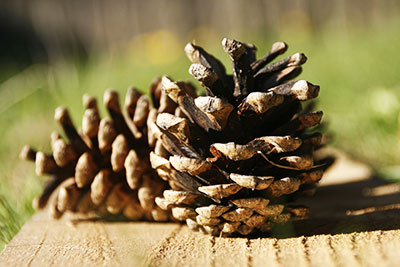COMPARISON OF THE ADSORPTION CAPACITY OF CARBON SORBENTS FROM DIFFERENT PLANT PRECURSORS
UDC 662.71
Abstract
The sorption capacity of activated carbon obtained from various plant precursors – apple wood, birch wood, pine cones and cellolignin was studied. The plant material was first subjected to carbonation by heating to a temperature of 700 °C and further exposure at this temperature. The total heating time was 8 hours. Charcoal was then subjected to steam activation at a reactor temperature of 950 °C and an activation time of 40–45 minutes. The yield of activated carbon estimated on charcoal was 42–46%. The characteristics of the porous structure were determined by the method of low-temperature nitrogen adsorption. The total specific surface area according to the BET method was (m2/g) 674, 594, 552, 552, 622 for apple wood, birch wood, pine cones, cellolignin and an industrial sample of activated carbon, respectively. Determination of the adsorption capacity by iodine adsorption methods showed that this value, depending on the source of raw materials, falls in the order: birch wood > cellolignin ≈ apple wood > pine cones. The data on the sorption of benzene characterize approximately the same range of sorption capacity: birch wood > cellolignin > pine cones ≈ apple wood. The data on the sorption capacity show that unconventional plant raw materials can be used to produce activated carbon.
Downloads
Metrics
References
Zhao W., Luo L., Wang H., Fan M. BioResources, 2017, vol. 12, no. 1, pp. 1246–1262. DOI: 10.15376/biores.12.1.1246-1262.
Chen Y., Liu D., Shen Z., Bao B., Zhao S., Wu L. Electrochemica Acta, 2015, vol. 180, pp. 241–251. DOI: 10.1016/j.electacta.2015.08.133.
Amerkhanova Sh., Uali A., Zhaslan R. Khimiya rastitel'nogo syr'ya, 2015, no. 1, pp. 205–209. DOI: 10.14258/jcprm.201501302. (in Russ.).
Zhao S., Chen L. Biomass Conversion and Biorefinery, 2020, pp. 1–11. DOI: 10.1007/s13399-020-00921-9.
Abe I., Fukuhara T., Iwasaki S., Yasuda K., Nakagawa K., Iwata Y., Kominami H., Kera Y. Carbon, 2001, vol. 39, pp. 1485–1490. DOI: 10.1016/S0008-6223(00)00273-6.
Tay T., Ucar S., Karagöz S. Journal of Hazardous Materials, 2009, vol. 165, pp. 481–485. DOI: 10.1016/j.jhazmat.2008.10.011.
Bouchelta C., Medjram M.S., Bertrand O., Bellat J.-P. Journal of Analytical and Applied Pyrolysis, 2008, vol. 82, pp. 70–77. DOI: 10.1016/j.jaap.2007.12.009.
Ahmad A., Loh M., Aziz J. Dyes and pigments, 2007, vol. 75, pp. 263–272. DOI: 10.1016/j.dyepig.2006.05.034.
Rugayah A., Astimar A., Norzita N. Journal of Oil Palm Research, 2014, vol. 26, pp. 251–264.
Zhang Y.-J., Xing Z.-J., Duan Z.-K., Li M., Wang Y. Applied Surface Science, 2014, vol. 315, pp. 279–286. DOI: 10.1016/j.apsusc.2014.07.126.
Mukhin V.M., Tarasov A.V., Klushin V.N. Aktivnyye ugli Rossii. [Active coals of Russia]. Moscow, 2000, 352 p. (in Russ.).
Marsh H., Rodriquez-Reinoso. Activated Carbon, 2006, 536 p.
Burakov A.E., Galunin E.V., Burakova I.V., Kucheriva A.E., Agarwal S., Tkachev A.G., Gupta V. Ecotoxicology and Environmental Safety, 2018, vol. 148, pp. 702–712. DOI: 10.1016/j.ecoenv.2017.11.034.
Yahya M.A., Al-Qodah Z., Zanariah Ngah C.W. Renewable and Sustainable Energy Reviews, 2015, vol. 46, pp. 218–235. DOI:10.1016/j.rser.2015.02.051.
Qiao Y., He C., Zhang C., Yi K., Li F. Bioresources, 2019, vol. 14, no. 4, pp. 9765–9780. DOI: 10.15376/biores.14.4.9766-9780.
Nanda S., Dalai A.K., Berruti F., Kozinski J.A. Waste Biomass Valor, 2016, vol. 7, no. 2, pp. 201–235. DOI: 10.1007/s12649-015-9459-z.
Obolenskaya A.V., Yel'nitskaya Z.P., Leonovich A.A. Laboratornyye raboty po khimii drevesiny i tsellyulozy. [Labor-atory work on the chemistry of wood and cellulose]. Moscow, 1991, 320 p. (in Russ.).
Chu K.N., Spitsyn A.A., Romanenko K.A., Ponomarev D.A. Lesnoy zhurnal, 2018, no. 4, pp. 140–149. DOI: 10.17238/issn0536-1036.2018.4.140. (in Russ.).
Beletskaya M.G. Sintez uglerodnykh sorbentov metodom termokhimicheskoy aktivatsii gidroliznogo lignina s ispol'zovaniyem gidroksida natriya: diss. … kand. khim. nauk. [Synthesis of carbon sorbents by thermochemical acti-vation of hydrolysis lignin using sodium hydroxide: diss. ... Cand. chem. sciences]. Arkhangel'sk, 2014, 153 p. (in Russ.).
Sing K.S.W. Pure and Applied Chemistry, 1985, vol. 57, no. 4, pp. 603‒619.

Copyright (c) 2021 chemistry of plant raw material

This work is licensed under a Creative Commons Attribution 4.0 International License.

This work is licensed under a Creative Commons Attribution 4.0 International License.
The authors, which are published in this journal, agree to the following conditions:
1. Authors retain the copyright to the work and transfer to the journal the right of the first publication along with the work, at the same time licensing it under the terms of the Creative Commons Attribution License, which allows others to distribute this work with the obligatory indication of the authorship of this work and a link to the original publication in this journal .
2. The authors retain the right to enter into separate, additional contractual agreements for the non-exclusive distribution of the version of the work published by this journal (for example, to place it in the university depository or to publish it in a book), with reference to the original publication in this journal.
3. Authors are allowed to post their work on the Internet (for example, in a university repository or on their personal website) before and during the review process of this journal, as this may lead to a productive discussion, as well as more links to this published work.











